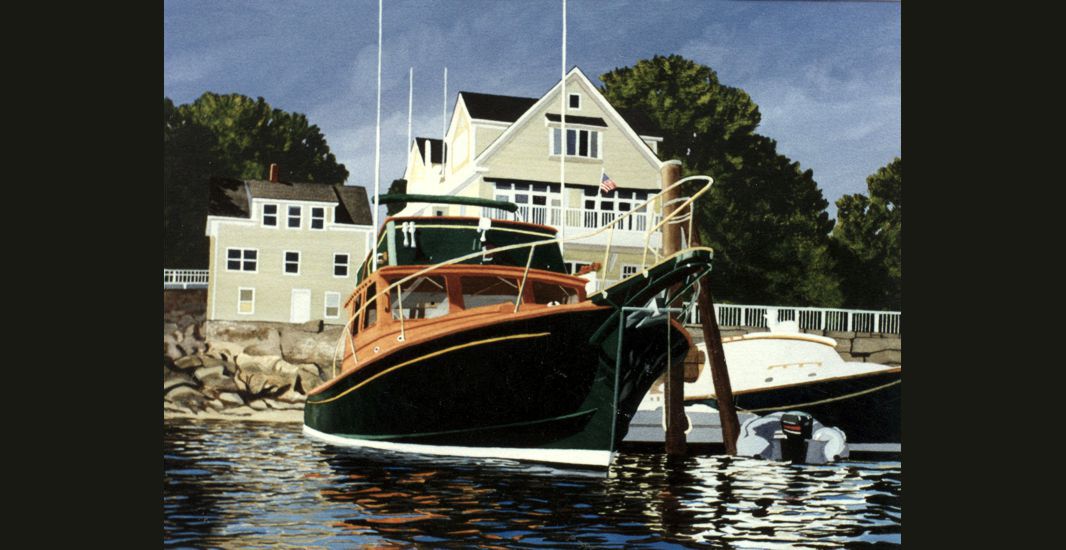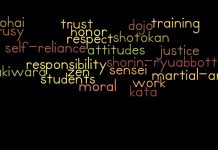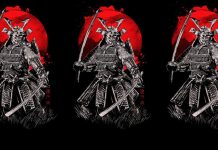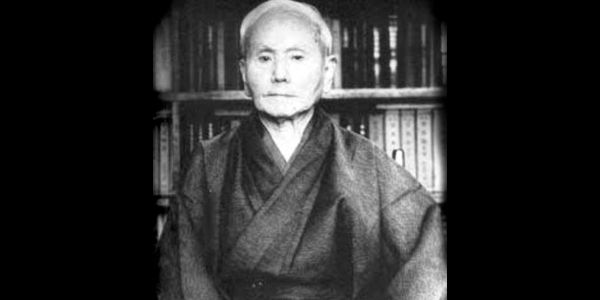 My favorite Gichin Funakoshi quote is: “Everything you encounter is an aspect of karate: find the marvelous truth there.”
My favorite Gichin Funakoshi quote is: “Everything you encounter is an aspect of karate: find the marvelous truth there.”
By Thomas A. Newnam ~ Did he say “everything?” Wow! I was totally intrigued when I first heard that quote. That was about thirty years ago. Even as new white belt, I understood that Master Funakoshi was presenting a profound truth about life, as well as karate. I had a feeling that if I dedicated myself to the martial arts, long enough and faithfully enough, I might someday discover something about this marvelous truth.
Fortunately I had joined a most suitable karate school. Like no other that I knew about, our small, uncelebrated school seemed to be a fertile training ground for such an idealistic truth seeker as myself. I was determined to find out what Funakoshi meant when he also said: “No one can attain perfection in karate-do until he finally comes to realize that it is, above all else, a faith – a way of life.”
My path unfolded something like this: A few years after returning from Vietnam and earning his black belt, one of my younger brothers, Randy, opened his own karate school. This was around 1976. As a testament to his solid and enlightened character, his dojo was as much a spiritual place of self-discovery and healing as it was a physically challenging and rigorous. Trusting my intuition that this was where I needed to be to learn traditional Shotokan Karate, I eagerly joined his first class of white belts.
Aside from stories I’d heard over the years of accounts of my brother’s own arduous training (including having to literally fend off his Sensei’s pet – a nippy lion cub – during some workouts) I knew nothing about karate. Being a social worker at the time, however, I guess I can say that I understood a little about people in general. Plus, given that I had also served in the military, gone to college, gotten married and had a baby, I can probably also say, with both a fair amount of correctness and humility, that I knew some things about myself, and perhaps even a little about life as well. So, looking back, I can see how the stage was well set for me to throw myself whole-heartedly into the mystery of karate.
In the beginning months and years of our training, we concentrated on building a solid foundation. This involved endless repetition of basic techniques. Sensei said it was like learning a new language; we had to learn the alphabet first and how to construct words, before we could really say anything.
Being the Sensei’s brother turned out not to be a position of special treatment. Moan! If anything, I had to work harder than the other students. After about ten years of dedicated study, I earned my black belt. What an amazing honor and privilege! I spent the next ten years, then, co-instructing with my brother.
In our dojo “Respect” was first and foremost. Respect for: oneself, one’s fellow trainees, the dojo, the teachers – going all the way back, of course, to the founding father of modern karate – Ginchin Funakoshi (whose photo we kept on the wall). And also…respect for karate in the broadest sense – as a way of life.
In terms of our affiliation with other schools, we competed now and then in tournaments, demonstrations, that kind of thing… but that was the exception rather than the rule. For the most part, we quietly (and I like to think, humbly) remained a side-path enclave of Funakoshi devotees, off from the mainstream. Generally, our students were a mixed group of dedicated men and women – all ages – from a wide variety of backgrounds and occupations. Even though our school stayed rather non-competitive, preferring instead to concentrate on good, solid, all-around-hard workouts within our own dojo, we honored and respected every other school’s unique way of accomplishing the same goal we had: to help the karateka become a better person.
Reportedly, Bruce Lee used to say: “It is easy to teach one to be skillful, but it is difficult to teach one his own attitude.” To help our karatekas gain a deeper understanding of their own attitudes, my brother and I developed a variety of therapeutic avenues, or additions, to our regular workout regimen. These training exercises were designed to help our students to identify the causes of, and effective management strategies for, their, most often self-imposed, stress.
For example, if a student had an anger management problem, we might modify bunkai (the understanding of a particular block or attack) a little, by having them visualize their opponent – as the embodiment of their own anger. That way in their imagination (a most underrated and very powerful force within each of us) every time they punched, kicked or threw down their opponent, they were prevailing over their own anger. Every time they blocked, they were keeping their “problem” from getting the best of them. More generally, along those same lines, we would often instruct our students, as they were moving back and forth across the dojo executing various combinations of blocks and attacks, to identify some personal weakness or problem area (perhaps something like insecurity, fear, or arrogance), and then, similarly, attack that undesirable trait. The same technique would apply if a trainee chose to focus on a larger, societal problem – such as poverty, disease or domestic violence.
We discovered that when students visualized their opponent as a fault, or negative habit they wanted to eliminate or grow beyond, rather than picturing some imaginary bully or brute out to do them harm, they were able to gain a better understanding of their own personalities, thereby, hopefully, attaining at least a glimpse of Funakoshi’s constant reminder: “Rather than physical technique – mental technique.”
We encouraged mental relaxation at all times. And we regularly taught various methods of quiet breathing exercises and meditation. Our purpose, and hope, was always to construct circumstances that would allow each karateka to get in touch with the deepest part of their essential selves – the inner calm of their soul.
These combined training exercises – mental and physical – enabled our students to take integrated and proactive steps toward helping themselves become more how they wanted to be. As instructors, we always felt that anytime we were able to help a student channel their energy in the direction of the enhancement of their character, we were on the right path.
I remember many nights, after a good workout, how we would all sit in a candlelit circle and openly share thoughts and feelings. While the issues discussed were mostly about karate, it never took long before we were able to help each other understand how in-class challenges and accomplishments could be translated to problem solving strategies outside of the dojo. I guess you could say we had our own version of karate therapy going on, using karate as a metaphor for life. Really, it was simply openness and sharing, with allowance, appreciation and respect for everyone’s differences.
Along the way, my brother and I remained conscious and concerned that some of our teaching methods were a little off the traditional karate path. And we often wondered what Master Funakoshi might say about our approach. In the long run, and for the following reasons, we felt both justified and thankful for staying with our innovative approach:
(1) We never let any creative, self-growth exercise interfere with our base line approach of always having a rigorous, traditional physical work out. Whether practicing basics, drills, katas, kumite, weapons, or free form expressions, we always maintained a crisp focus on important details as to how body mechanics work (e.g. staying low to keep our center of gravity down…and using hip rotation to generate power) in accordance with our best interpretation of Funakoshi’s teachings.
(2) The more our students invested their minds and imaginations into the workouts, along with the hard-to-avoid blood, sweat and tears, the deeper their commitment became. Several of our black belts shared with us, later and gratefully, that if we had only taught the physical side of karate, they would have dropped out years before.
(3) Our students, commonly and consistently, reported that the lessons they learned about themselves, in the dojo, better prepared them to deal with life’s challenges outside of class. The consensus was that our mind-body-spirit methods of training made karate personal and practical, and helped our karatekas to become more comfortable with their most authentic selves. What more useful self-defense posture can there be than a solid measure of self-knowledge and self-awareness? We were also told (bemusedly, as I look back on it) that our methods of ‘making people think’ actually made the workouts harder. As one student put it, “Man you sure make us use a lot of energy.”
(4) Most importantly, and without arrogance or any presumption that we knew more than anybody else, we taught the way we did out of a reverence for Master Funakoshi. We sincerely strived to honor all that we believed he (his life) stood for. I humbly submit that our group of wisdom warriors should probably get a high grade for effort because we really took his quotes to heart….and to life. We, consciously and for the best of reasons we could think of, used all of our human attributes and abilities to faithfully explore the mystery of Funakoshi’s karate. And the vehicle…the pathway…the most direct route…the only way, really – was through the courageous exploration of ourselves.
Personally, I can’t imagine where I’d be today without karate. Everything I learned in class, which was always just as much when I was teaching (especially the attitude of respect and the understanding that in life, as well as in karate – you are your own opponent) has made me a happier, healthier person today. And I definitely have more self discipline. In terms of managing chi, and knowing when and how to direct energy in all circumstances – my karate training has been invaluable. I find myself constantly (and naturally now) thinking about opposite energies – hard and soft, relaxation and tension, pushing and pulling, moving into or moving away from situations, real or imagined. I’ve got karate on the brain. Blocks and attacks have become wonderful mental metaphors – growth tools – that I consciously use to help me better address even the most ordinary challenges. And I meditate every day.
Though I am no longer involved with any official martial arts dojo, spend most of my time in my watercolor art studio (I’ve been a full time, professional artist for the last thirty years), and work out infrequently, I still honor and practice my version of a kind of indescribable, spiritual martial art that not only enables but practically compels me to implement non-physical energy techniques from my heart…while rooted in a stance of compassion.
I would never claim, especially after only a few decades of martial arts study, that I’ve even come close to fully “knowing” the marvelous truth that Master Funakoshi encouraged us to discover. That would indeed be presumptuous, if not ridiculous. But I know for sure that because of my quest to understand this great man’s compassionate challenge, I have better tools in my personal growth arsenal – more arrows in my quiver, so to speak now…than I would have otherwise. Obvious personal gains and benefits from my martial arts involvement include increased: self-awareness, self-confidence, compassion, humility, and appreciation for even the most ordinary things in life. I sometimes even think I’m starting to understand what Lao-tzu meant when he said: “knowing others is intelligence; knowing yourself is wisdom.”
I don’t claim to possess much wisdom, but I cannot deny that I am filled with tons of gratitude…to my brother and his teachers before him – all karate visionaries – for helping me discover more of my Self, than I ever knew was possible.
Our wonderful school is no longer in operation. All of our black belts moved on, either to open their own school or pursue other dreams. My brother become a business man, a pilot, and now days a highly respected sea captain – practicing karate with every breath he takes, I have no doubt.
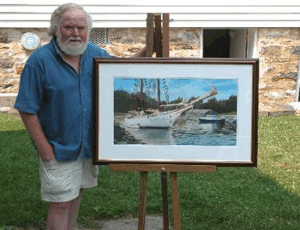
So…it is my firm belief that if you give yourself the gift of karate, and stay with your martial arts studies long enough – allowing yourself to become uncomfortably vulnerable, and tired, much of the time – and if you make personal growth changes when needed — karate will help you discover the most marvelous truth that: as a soul most worthy of Respect, you can find happiness and fulfillment, live a life of purpose, and most importantly… have more to offer others because you have more of your marvelous Self.
Thank you very much for considering my personal perspective.
Sensei Newnam is a martial artist and a professional watercolor artist. He is also a freelance writer. Having been a juvenile probation officer and a psychotherapist, most of his writings tend to be about issues concerning mind/body/spirit mental health. Tom has recently written a self-help book that, hopefully, will appeal to anyone seeking to grow more into themselves. He is exploring his options with potential literary agents at this time. To learn more about Tom’s creative endeavors, and to keep tabs on when his book will be available – visit his web site: www.sageandbrush.com

